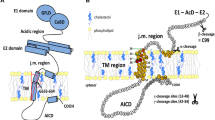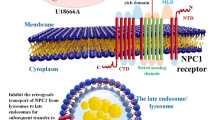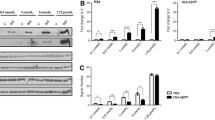Abstract
Increased amyloid beta (AB) peptide concentration is one of the initiating factors in the neurodegeneration process. It has been suggested that cholesterol induces the synthesis of AB peptide from amyloid precursor protein or facilitates the formation of amyloid plaque by lowering the aggregation threshold of the peptide. It is also shown that AB peptides may affect cholesterol metabolism and the synthesis of steroid hormones such as progesterone and estradiol. Pregnenolone (P) and pregnenolone sulfate (PS) are the major steroids produced from cholesterol in neural tissue. In toxicity conditions, the effect of AB peptides on P and PS levels has not yet been determined. Furthermore, it has not been clearly defined how changes in cellular P and PS levels affect neuronal cell survival. The aim of this study was to determine the effects of AB peptides on cellular changes in P and PS levels depending on the level of their main precursor, cholesterol. Cholesterol and toxic concentrations of AB fragments (AB 25–35, AB 1–40 and AB 1–42) were applied to PC-12 and SH-SY5Y cells. Changes in cellular cholesterol, P and PS levels were determined simultaneously in a dose—and time-dependent manner. The cell viability and cell death types were also evaluated. AB peptides affected both cell viability and P/PS levels. Steroid levels were altered depending on AB fragment type and the cholesterol content of the cells. Treatment with each of the AB fragments alone increased P levels by twofold. However, combined treatment with AB peptides and cholesterol increased P levels by approximately sixfold, while PS levels were increased only about 2.5 fold in both cell lines. P levels in the groups treated with AB 25–35 were higher than those in AB 1–40 and AB 1–42 groups. The cell viabilities were significantly low in the group treated by AB and cholesterol (9 mM). The effect of AB peptides on P levels might be a result of cellular self-defense. On the other hand, the rate of P increase might be playing a key role in the cell death mechanism of AB toxicity depending on cellular cholesterol levels.










Similar content being viewed by others
References
World Alzheimer Report (2014) Dementia and risk reduction. 2014. http://www.alz.co.uk/research/world-report-2014
World Health Organization (Media centre) Dementia March 2015. http://www.who.int/mediacentre/factsheets/fs362/en/
Zhu X, Perry G, Smith MA, Wang X (2013) Abnormal mitochondrial dynamics in the pathogenesis of Alzheimer’s disease. J Alzheimer’s Dis: JAD 33(Suppl 1):S253–S262
Nalivaeva NN, Turner AJ (2013) The amyloid precursor protein: a biochemical enigma in brain development, function and disease. FEBS Lett 587(13):2046–2054
De-Paula VJ, Radanovic M, Diniz BS, Forlenza OV (2012) Alzheimer’s disease. Sub-cell Biochem 65:329–352
Gamblin TC, Chen F, Zambrano A, Abraha A, Lagalwar S, Guillozet AL et al (2003) Caspase cleavage of tau: linking amyloid and neurofibrillary tangles in Alzheimer’s disease. Proc Natl Acad Sci USA 100(17):10032–10037
Hardy J, Selkoe DJ (2002) The amyloid hypothesis of Alzheimer’s disease: progress and problems on the road to therapeutics. Science 297(5580):353–356
Ling Y, Morgan K, Kalsheker N (2003) Amyloid precursor protein (APP) and the biology of proteolytic processing: relevance to Alzheimer’s disease. Int J Biochem Cell Biol 35(11):1505–1535
Przedborski S, Vila M, Jackson-Lewis V (2003) Neurodegeneration: what is it and where are we? J Clin Investig 111(1):3–10
Morley JE, Farr SA (2014) The role of amyloid-beta in the regulation of memory. Biochem Pharmacol 88(4):479–485
Finder VH, Glockshuber R (2007) Amyloid-beta aggregation. Neuro-degener Dis 4(1):13–27
Masters CL, Simms G, Weinman NA, Multhaup G, McDonald BL, Beyreuther K (1985) Amyloid plaque core protein in Alzheimer disease and Down syndrome. Proc Natl Acad Sci USA 82(12):4245–4249
Cole SL, Vassar R (2007) The Alzheimer’s disease beta-secretase enzyme, BACE1. Mol Neurodegener 2:22
Evin G, Weidemann A (2002) Biogenesis and metabolism of Alzheimer’s disease Abeta amyloid peptides. Peptides 23(7):1285–1297
Simmons LK, May PC, Tomaselli KJ, Rydel RE, Fuson KS, Brigham EF et al (1994) Secondary structure of amyloid beta peptide correlates with neurotoxic activity in vitro. Mol Pharmacol 45(3):373–379
Wang R, Sweeney D, Gandy SE, Sisodia SS (1996) The profile of soluble amyloid beta protein in cultured cell media. Detection and quantification of amyloid beta protein and variants by immunoprecipitation-mass spectrometry. J Biol Chem 271(50):31894–31902
Yankner BA, Duffy LK, Kirschner DA (1990) Neurotrophic and neurotoxic effects of amyloid beta protein: reversal by tachykinin neuropeptides. Science 250(4978):279–282
Lee SY, Lee JW, Lee H, Yoo HS, Yun YP, Oh KW et al (2005) Inhibitory effect of green tea extract on beta-amyloid-induced PC12 cell death by inhibition of the activation of NF-kappaB and ERK/p38 MAP kinase pathway through antioxidant mechanisms. Brain Res Mol Brain Res 140(1–2):45–54
Stepanichev MY, Moiseeva YV, Lazareva NA, Onufriev MV, Gulyaeva NV (2003) Single intracerebroventricular administration of amyloid-beta (25–35) peptide induces impairment in short-term rather than long-term memory in rats. Brain Res Bull 61(2):197–205
Stepanichev MY, Zdobnova IM, Zarubenko II, Moiseeva YV, Lazareva NA, Onufriev MV et al (2004) Amyloid-beta(25–35)-induced memory impairments correlate with cell loss in rat hippocampus. Physiol Behav 80(5):647–655
Stepanichev MY, Onufriev MV, Yakovlev AA, Khrenov AI, Peregud DI, Vorontsova ON et al (2008) Amyloid-beta (25-35) increases activity of neuronal NO-synthase in rat brain. Neurochem Int 52(6):1114–1124
Li G, Ma R, Huang C, Tang Q, Fu Q, Liu H et al (2008) Protective effect of erythropoietin on beta-amyloid-induced PC12 cell death through antioxidant mechanisms. Neurosci Lett 442(2):143–147
Schaeffer V, Meyer L, Patte-Mensah C, Eckert A, Mensah-Nyagan AG (2008) Dose-dependent and sequence-sensitive effects of amyloid-beta peptide on neurosteroidogenesis in human neuroblastoma cells. Neurochem Int 52(6):948–955
Brown RC, Cascio C, Papadopoulos V (2000) Pathways of neurosteroid biosynthesis in cell lines from human brain: regulation of dehydroepiandrosterone formation by oxidative stress and beta-amyloid peptide. J Neurochem 74(2):847–859
Pikuleva IA (2006) Cholesterol-metabolizing cytochromes P450. Drug Metab Dispos 34(4):513–520
Stefani M, Liguri G (2009) Cholesterol in Alzheimer’s disease: unresolved questions. Curr Alzheimer Res 6(1):15–29
Vallee M, Purdy RH, Mayo W, Koob GF, Le Moal M (2003) Neuroactive steroids: new biomarkers of cognitive aging. J Steroid Biochem Mol Biol 85(2–5):329–335
Herson PS, Koerner IP, Hurn PD (2009) Sex, sex steroids, and brain injury. Semin Reprod Med 27(3):229–239
Mellon SH (2007) Neurosteroid regulation of central nervous system development. Pharmacol Ther 116(1):107–124
Baulieu EE, Robel P, Schumacher M (2001) Neurosteroids: beginning of the story. Int Rev Neurobiol 46:1–32
Guarneri P, Cascio C, Russo D, D’Agostino S, Drago G, Galizzi G et al (2003) Neurosteroids in the retina: neurodegenerative and neuroprotective agents in retinal degeneration. Ann N Y Acad Sci 1007:117–128
Marx CE, Jarskog LF, Lauder JM, Gilmore JH, Lieberman JA, Morrow AL (2000) Neurosteroid modulation of embryonic neuronal survival in vitro following anoxia. Brain Res 871(1):104–112
Schaeffer V, Patte-Mensah C, Eckert A, Mensah-Nyagan AG (2008) Selective regulation of neurosteroid biosynthesis in human neuroblastoma cells under hydrogen peroxide-induced oxidative stress condition. Neuroscience 151(3):758–770
Charalampopoulos I, Remboutsika E, Margioris AN, Gravanis A (2008) Neurosteroids as modulators of neurogenesis and neuronal survival. Trends Endocrinol Metab 19(8):300–307
Guarneri P, Russo D, Cascio C, De Leo G, Piccoli F, Guarneri R (1998) Induction of neurosteroid synthesis by NMDA receptors in isolated rat retina: a potential early event in excitotoxicity. Eur J Neurosci 10(5):1752–1763
Akan P, Kizildag S, Ormen M, Genc S, Oktem MA, Fadiloglu M (2009) Pregnenolone protects the PC-12 cell line against amyloid beta peptide toxicity but its sulfate ester does not. Chem Biol Interact 177(1):65–70
Gursoy E, Cardounel A, Kalimi M (2001) Pregnenolone protects mouse hippocampal (HT-22) cells against glutamate and amyloid beta protein toxicity. Neurochem Res 26(1):15–21
Cascio C, Guarneri R, Russo D, De Leo G, Guarneri M, Piccoli F et al (2002) A caspase-3-dependent pathway is predominantly activated by the excitotoxin pregnenolone sulfate and requires early and late cytochrome c release and cell-specific caspase-2 activation in the retinal cell death. J Neurochem 83(6):1358–1371
Evans RM, Hui S, Perkins A, Lahiri DK, Poirier J, Farlow MR (2004) Cholesterol and APOE genotype interact to influence Alzheimer disease progression. Neurology 62(10):1869–1871
Puglielli L, Tanzi RE, Kovacs DM (2003) Alzheimer’s disease: the cholesterol connection. Nat Neurosci 6(4):345–351
Hall JR, Wiechmann AR, Johnson LA, Edwards M, Barber RC, Cunningham R et al (2014) Total cholesterol and neuropsychiatric symptoms in Alzheimer’s disease: the impact of total cholesterol level and gender. Dement Geriatr Cogn Disord 38(5–6):300–309
Reiman EM, Chen K, Langbaum JB, Lee W, Reschke C, Bandy D et al (2010) Higher serum total cholesterol levels in late middle age are associated with glucose hypometabolism in brain regions affected by Alzheimer’s disease and normal aging. NeuroImage 49(1):169–176
Shepardson NE, Shankar GM, Selkoe DJ (2011) Cholesterol level and statin use in Alzheimer disease: II. Review of human trials and recommendations. Arch Neurol 68(11):1385–1392
Prasanthi JR, Huls A, Thomasson S, Thompson A, Schommer E, Ghribi O (2009) Differential effects of 24-hydroxycholesterol and 27-hydroxycholesterol on beta-amyloid precursor protein levels and processing in human neuroblastoma SH-SY5Y cells. Mol Neurodegener 4:1
Colell A, Fernandez A, Fernandez-Checa JC (2009) Mitochondria, cholesterol and amyloid beta peptide: a dangerous trio in Alzheimer disease. J Bioenerg Biomembr 41(5):417–423
Prasanthi RPJ, Schommer E, Thomasson S, Thompson A, Feist G, Ghribi O (2008) Regulation of beta-amyloid levels in the brain of cholesterol-fed rabbit, a model system for sporadic Alzheimer’s disease. Mech Ageing Dev 129(11):649–655
Di Scala C, Chahinian H, Yahi N, Garmy N, Fantini J (2014) Interaction of Alzheimer’s beta-amyloid peptides with cholesterol: mechanistic insights into amyloid pore formation. Biochemistry 53(28):4489–4502
Cossec JC, Marquer C, Panchal M, Lazar AN, Duyckaerts C, Potier MC (2010) Cholesterol changes in Alzheimer’s disease: methods of analysis and impact on the formation of enlarged endosomes. Biochim Biophys Acta 1801(8):839–845
Tillement JP, Lecanu L, Papadopoulos V (2010) Amyloidosis and neurodegenerative diseases: current treatments and new pharmacological options. Pharmacology 85(1):1–17
Bodovitz S, Klein WL (1996) Cholesterol modulates alpha-secretase cleavage of amyloid precursor protein. J Biol Chem 271(8):4436–4440
Guarneri P, Cascio C, Piccoli T, Piccoli F, Guarneri R (2000) Human neuroblastoma SH-SY5Y cell line: neurosteroid-producing cell line relying on cytoskeletal organization. J Neurosci Res 60(5):656–665
Mruthinti S, Capito N, Sood A, Buccafusc JJ (2007) Cytotoxicity of Abeta1-42, RAGE23-54, and an Abeta-RAGE complex in PC-12 cells. Curr Alzheimer Res 4(5):581–586
Schaeffer V, Patte-Mensah C, Eckert A, Mensah-Nyagan AG (2006) Modulation of neurosteroid production in human neuroblastoma cells by Alzheimer’s disease key proteins. J Neurobiol 66(8):868–881
Zhou YQ, Yang ZL, Xu L, Li P, Hu YZ (2009) Akebia saponin D, a saponin component from Dipsacus asper Wall, protects PC 12 cells against amyloid-beta induced cytotoxicity. Cell Biol Int 33(10):1102–1110
Portelius E, Zetterberg H, Gobom J, Andreasson U, Blennow K (2008) Targeted proteomics in Alzheimer’s disease: focus on amyloid-beta. Expert Rev Proteomics 5(2):225–237
Irie K, Murakami K, Masuda Y, Morimoto A, Ohigashi H, Ohashi R et al (2005) Structure of beta-amyloid fibrils and its relevance to their neurotoxicity: implications for the pathogenesis of Alzheimer’s disease. J Biosci Bioeng 99(5):437–447
Calan OG, Akan P, Bagriyanik HA, Fadiloglu M (2014) The assessment of vital responses of human and rat neuronal cells against to amyloid beta peptide and neuroactive steroid treatment. J Neurol Sci Turk 31(1):28–39
Runz H, Rietdorf J, Tomic I, de Bernard M, Beyreuther K, Pepperkok R et al (2002) Inhibition of intracellular cholesterol transport alters presenilin localization and amyloid precursor protein processing in neuronal cells. J Neurosci 22(5):1679–1689
Schumacher M, Liere P, Akwa Y, Rajkowski K, Griffiths W, Bodin K et al (2008) Pregnenolone sulfate in the brain: a controversial neurosteroid. Neurochem Int 52(4–5):522–540
Semeniuk T, Jhangri GS, Le Melledo JM (2001) Neuroactive steroid levels in patients with generalized anxiety disorder. J Neuropsychiatry Clin Neurosci 13(3):396–398
Fernandez A, Llacuna L, Fernandez-Checa JC, Colell A (2009) Mitochondrial cholesterol loading exacerbates amyloid beta peptide-induced inflammation and neurotoxicity. J Neurosci 29(20):6394–6405
Gamble W, Vaughan M, Kruth HS, Avigan J (1978) Procedure for determination of free and total cholesterol in micro- or nanogram amounts suitable for studies with cultured cells. J Lipid Res 19(8):1068–1070
Tagawa N, Nakata Y, Kusuda S, Kobayashi Y, Watanabe F (1997) Serum levels of 16-dehydropregnenolone sulfate during the early neonatal period. Biol Pharm Bull 20(1):76–78
Tagawa N, Tamanaka J, Fujinami A, Kobayashi Y, Takano T, Fukata S et al (2000) Serum dehydroepiandrosterone, dehydroepiandrosterone sulfate, and pregnenolone sulfate concentrations in patients with hyperthyroidism and hypothyroidism. Clin Chem 46(4):523–528
Beaujean D, Mensah-Nyagan AG, Do-Rego JL, Luu-The V, Pelletier G, Vaudry H (1999) Immunocytochemical localization and biological activity of hydroxysteroid sulfotransferase in the frog brain. J Neurochem 72(2):848–857
Shirakawa H, Katsuki H, Kume T, Kaneko S, Akaike A (2006) Aminoglutethimide prevents excitotoxic and ischemic injuries in cortical neurons. Br J Pharmacol 147(7):729–736
Zhu TS, Glaser M (2008) Regulatory role of cytochrome P450scc and pregnenolone in myelination by rat Schwann cells. Mol Cell Biochem 313(1–2):79–89
Mosmann T (1983) Rapid colorimetric assay for cellular growth and survival: application to proliferation and cytotoxicity assays. J Immunol Methods 65(1–2):55–63
Lobner D (2000) Comparison of the LDH and MTT assays for quantifying cell death: validity for neuronal apoptosis? J Neurosci Methods 96(2):147–152
van Engeland M, Nieland LJ, Ramaekers FC, Schutte B, Reutelingsperger CP (1998) Annexin V-affinity assay: a review on an apoptosis detection system based on phosphatidylserine exposure. Cytometry 31(1):1–9
Westerink RH, Ewing AG (2008) The PC12 cell as model for neurosecretion. Acta Physiol 192(2):273–285
Baulieu EE (1998) Neurosteroids: a novel function of the brain. Psychoneuroendocrinology. 23(8):963–987
Wang M (2011) Neurosteroids and GABA-a receptor function. Front Endocrinol 2:44
Weill-Engerer S, David JP, Sazdovitch V, Liere P, Eychenne B, Pianos A et al (2002) Neurosteroid quantification in human brain regions: comparison between Alzheimer’s and nondemented patients. J Clin Endocrinol Metab 87(11):5138–5143
Refolo LM, Malester B, LaFrancois J, Bryant-Thomas T, Wang R, Tint GS et al (2000) Hypercholesterolemia accelerates the Alzheimer’s amyloid pathology in a transgenic mouse model. Neurobiol Dis 7(4):321–331
Kohjitani A, Fuda H, Hanyu O, Strott CA (2008) Regulation of SULT2B1a (pregnenolone sulfotransferase) expression in rat C6 glioma cells: relevance of AMPA receptor-mediated NO signaling. Neurosci Lett 430(1):75–80
Plassart-Schiess E, Baulieu EE (2001) Neurosteroids: recent findings. Brain Res Brain Res Rev 37(1–3):133–140
Stoffel-Wagner B (2001) Neurosteroid metabolism in the human brain. Eur J Endocrinol 145(6):669–679
Guarneri P, Russo D, Cascio C, De Leo G, Piccoli T, Sciuto V et al (1998) Pregnenolone sulfate modulates NMDA receptors, inducing and potentiating acute excitotoxicity in isolated retina. J Neurosci Res 54(6):787–797
Acknowledgments
This work was supported by The Scientific and Technological Research Council of Turkey (TUBİTAK 1001 Research Project No: 110S412).
Author information
Authors and Affiliations
Corresponding author
Ethics declarations
Conflict of interest
The authors have no conflict of interest to declare.
Rights and permissions
About this article
Cite this article
Calan, O.G., Akan, P., Cataler, A. et al. Amyloid Beta Peptides Affect Pregnenolone and Pregnenolone Sulfate Levels in PC-12 and SH-SY5Y Cells Depending on Cholesterol. Neurochem Res 41, 1700–1712 (2016). https://doi.org/10.1007/s11064-016-1886-0
Received:
Revised:
Accepted:
Published:
Issue Date:
DOI: https://doi.org/10.1007/s11064-016-1886-0




